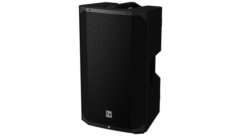

One of my favorite handheld dynamic microphones of all time is ElectroVoice’s PL80a, the brand’s top supercardioid dynamic that is frequency-sculpted to translate vocals in live environments, allowing them to sit notably snug in a mix. At $99, it’s affordable and flexible; it works great in just about any microphone application—live, recording, budget VO, etc.
For that reason, I was quite eager to try E-V’s new ND Series of live microphones which features four handheld vocal and four instrument models, all of which are dynamics except one small diaphragm condenser, the ND66 ($199 street, not reviewed here). Hardly average live microphone fare, the ND range is packed full of interesting proprietary technology.
First launched at NAMM 2016, the ND Series is centered on a new E-V large Mylar diaphragm; the company combines it with next-level design elements first born in their N/Dym Series, an already impressive line of microphones. In use, standout features include beautifully voiced, surprisingly feedback-resistant handheld microphones and equally flattering, feature-rich instrument models that are a hoot to position on drums, guitar cabinets, instruments, etc. In my review kit, I received the ND96 ($199 street) supercardioid, ND86 ($159 street) supercardioid and ND76 ($129 street) cardioid vocal microphones and the ND44 ($129 street) “tight” cardioid, ND46 ($159 street) supercardioid and ND68 ($199 street) supercardioid “low frequency” instrument microphones.
Within the trio of handhelds, notable features include a four-point shock mount suspension system that works really well at abating handling noise, a >140 dB maximum SPL and “flattering, not flat” frequency responses that bring out the best tonalities in vocal signal transduction. The ND96 usefully provides a two-position presence switch; one setting is relatively flat, while the other emphasizes lows and further dips “honky” mids so well that I left it engaged across a broad range of vocalists—male, female, of various types and styles. Usefully, the three handhelds look different, so for the engineer in typical low-lighting settings, grabbing the right one should be easy.

I was even more impressed with the instrument models within the ND Series. Not only do they sound great and are well voiced frequency-wise for their applications—see the link below for detailed frequency response and polar pattern data—mounting and positioning features make them unique and really valuable in the pro audio marketplace. For example, the ND44 comes with the DRC-2 drum rim clamp, which is one of the simpler yet completely functional such mounts I’ve seen; it also has a low profile pivoting head that allows precise angling on, for example, the right spot on a snare drum. The larger MD46 also comes with a pivoting head, but it locks into place, making it resistant to move even when heavily vibrated; this surely seems to be a refinement from careful refinement of the N/Dym Series.
Finally, the “kick drum and low frequency” ND68 actually handles up to 144 dB SPL and is punchy yet phat and voluptuous—most everything an engineer wants in such a microphone. It has a big frequency bump between approximately 1-10 kHz before dropping out at 11 kHz, and impressively reaches down to 20 Hz (@-5dB), too—all good stuff.
In total, the ND Series provides thoughtful new ways to better capture live sound without reinventing the wheel. Live sound, theater and house-of-worship-based audio engineers should love these microphones and will appreciate their affordable prices.
Strother Bullins is Technology Editor for NewBay Media’s AV/Pro Audio Group. sbullins@nbmedia.com










